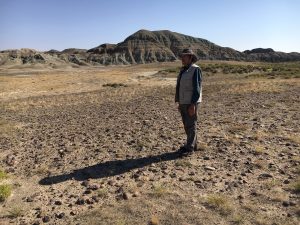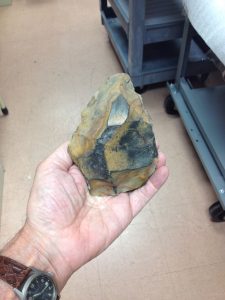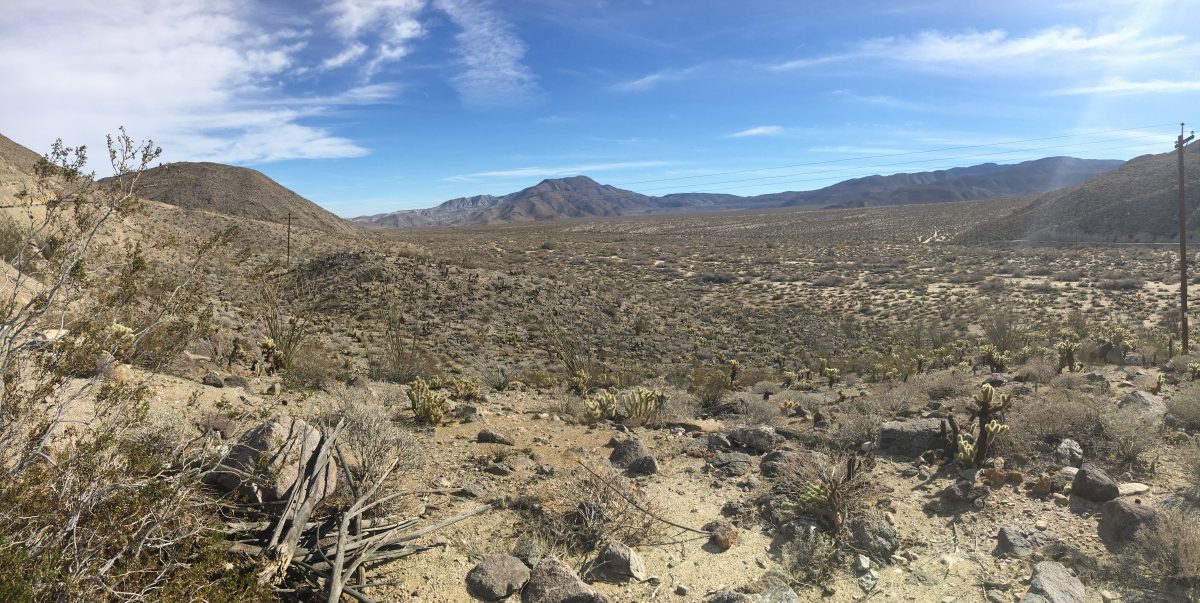In the summer of 2017 in the last days of innocence before the plague would blight our days, we found ourselves in southwestern Wyoming searching for a lost archaeological site. Discovered in the late 1930s, the site’s precise location had slipped away. The archaeologist provided only a rough sketch map of the location and no photographs of the site or its surroundings. Even more confusingly, the roads and monuments used on the sketch map for reference had been changed during road construction in the 1980s.
The site is important because it was once the center of an archaeological controversy, one that is being revived today. It is not an eye-catching ruin: it consists of large numbers of flaked stone tools made from chert scattered along the highest Pleistocene (last Ice Age) terrace of the Blacks Fork River a few miles from the historic site of Fort Bridger on the emigrant trail that led to Utah, California, and Oregon.
The site was discovered by the archaeologist E. B. Renaud, who has also slipped from view. Renaud was based at the University of Denver in Colorado where he specialized in the study of the earliest cultures in the United States and is perhaps best known, if at all, for the discovery of the site at Blacks Fork.
Renaud explored the Rocky Mountain states in the 1920s and 1930s following the discovery of the Folsom culture in New Mexico in 1926 that resulted in the recognition that early humans were in North America in the Pleistocene more than 10,000 years ago. He conducted numerous archaeological surveys and excavations that resulted in more than 100 publications.
In 1935 Renaud and his team surveyed the terraces of the Blacks Fork in response to a tip from local amateur archaeologists. E. B. (as he was known) was surprised by what he found. The stone tools along the terrace were not like the commonly known artifacts made by the indigenous peoples of North America in the last 10,000 years. They resembled instead the types of artifacts found in Africa and Europe that belong to the early Palaeolithic dating back more than 100,000 years. Though E. B. was unable to date the site, he knew that if the artifacts were Palaeolithic the Blacks Fork Culture (as he called it) could be a vestige of the earliest inhabitants of the Americas.
E. B. collected nearly 1,000 artifacts from Blacks Fork between 1935 and 1938 which are stored today in the Museum of Anthropology at the University of Denver (where we studied them in 2015). He published his findings and even took specimens to Europe to show to Palaeolithic specialists in an effort to confirm his findings. For a brief time the Blacks Fork Culture was the center of archaeological speculation about the peopling of the New World. This fame did not last: most research on the topic came to a halt during the Second World War and was slow to resume afterwards. Then a new idea, today called the Clovis First model, took hold. The Clovis First model posits that people only entered North America once, about 12,000 years ago, by crossing the Beringian land bridge from Siberia to Alaska and traversing an Ice Free Corridor in the glaciers to reach the lower 48 states of the US. An early Palaeolithic culture simply did not fit this model and the Blacks Fork Culture disappeared from the literature on the early prehistory of the Americas. Renaud retired in 1948 and was either unable or was unwilling to pursue his research at Blacks Fork. The publications would rest on library shelves and the artifacts in their boxes in the museum for 75 years. Even the location of the site was forgotten.
Who was E. B.? Etienne Bernardeau Renaud was born in Billancourt-Bologne, France, in 1880. He studied anthropology, paleontology and primitive art at the University of Paris before immigrating to the United States in 1909 (he became a citizen in 1913). He taught French in Santa Fe and studied at the Catholic University of Washington. In 1916 he returned to France as a soldier. He returned to Denver to earn a PhD in Anthropology at the University of Colorado in Boulder and in 1920 he became a lecturer at the University of Denver where he helped establish the Department of Anthropology. In 1923 he became Professor of Anthropology, and in 1931 he founded the Denver University Museum of Anthropology. E. B was also the French Consular Agent in Denver, for which service he received a medal from France. Professor Renaud died in 1973.
We are intrigued by Renaud’s background because his training and experience with Palaeolithic sites in Europe make it unlikely that his identification of the Blacks Fork artifacts was simply a mistake. He studied archaeology during a period when France was a leader in the field of Palaeolithic archaeology, and he returned several times to Europe in the 1920s and 1930s to keep in touch with the latest developments. During these trips he visited sites and studied museum collections. Photographs in the Renaud Archive show him at key sites like Le Solutré, Le Moustier, Laugerie Haute, La Micoque, and La Ferrassie in France, Spy in Belgium, Krapina in Croatia, and Ipswich in England. He had a keen interest in the archaeology of the cultures of the Neanderthals and early modern humans in the Palaeolithic from roughly 250 to 15 thousand years ago and had hands-on experience with their characteristic stone tools.
Our investigation began with a visit to the Museum of Anthropology at the University of Denver to study the artifacts. We were surprised by what we discovered: E. B. had been right, at least in so far as the artifacts are indeed similar in form and method of manufacture to artifacts from the Palaeolithic cultures from Africa, Europe, and much of Asia. For example, there are large almond-shaped tools called handaxes (and a suite of stone tools that go with the handaxes called picks, cleavers, massive scrapers, and choppers), as well as pointed flakes struck from carefully prepared and shaped cores (called the Levallois technique). Archaeological methods, including the ways that stone tools are classified, have changed since E. B.’s time, yet our analysis showed these tool types, especially because they occur in coherent groups we can call “toolkits,” would be regarded as “Palaeolithic” if they were found along the banks of the Seine River in France rather than a remote outpost in Wyoming. The similarities of the Blacks Fork artifacts to Palaeolithic types is a controversial claim, but we believe that it should be taken seriously and investigated further.
There is a catch. E. B. was unable to assign the Blacks Fork Culture to a particular period of time because the artifacts are not found in layers that can be dated. They are found embedded in what are called desert pavements, layers of rocks that form hard surfaces and which have been created by natural processes. The location of the desert pavements on an old terrace that dates to the Pleistocene is suggestive—but not proof—of a great age for the artifacts. The fact remains, however, that they are “floating in time.” There is evidence that some of the distinctive characteristics of the Blacks Fork artifacts can also be found among the earliest sites in the region, like Cooper’s Ferry in Idaho that is dated to 16,000 years ago. That is old, but not as old as the Palaeolithic in the Old World.
The next step was to find the site. While we were at the University of Denver preparing a report on the stone tools we went through E. B.’s papers stored in the University’s Special Collections. In a box we found two photographs that showed E. B. standing in a barren western landscape, and on the back of one the pencilled notation of a site number. It happened to be the Blacks Fork type site. That photograph brought us to Wyoming where at Fort Bridger the helpful park docents explained how the roads and monuments on E. B.’s original sketch map showing the location of the site were no longer in the same locations. With their help we were able to reconcile the old map with a modern map and, after some back and forth searching, we found the exact spot where E. B. was standing and where, triumphantly, I assumed the same position as in E. B.’s photograph to fix the location.
What have we found and what is the significance of the Blacks Fork Culture today? Since the mid-1990s archaeologists have been moving gradually away from the Clovis First model and considering the possibility that humans may have arrived in the Americas much earlier in time. The Blacks Fork Culture may help to form a new picture of the spread of the first peoples in the Americas. This is not yet possible. Much new research must be done. At present our working hypothesis is that the Blacks Fork Culture may have been produced by early humans who brought with them a broadly Eurasian “Blueprint” for making simple tools necessary for hunting, foraging, and gathering, a type of stone tool culture that may have given rise to archaeological cultures like the Western Stemmed Tradition found at Cooper’s Ferry. How old is the Blacks Fork Culture? At present we have no way of knowing. It is time to dust off E. B.’s old notes and artifacts and pick up the story where he left it off on the banks of the Blacks Fork River.
Further Reading:
Curtis Runnels and Priscilla Murray, 2022, “The Blacks Fork Culture of Southwestern Wyoming: Quarry Refuse or a Lithic Culture?” in George Jefferson, Steven R. Holen, and Kathleen A. Holen, eds., New Discoveries in the American Paleolithic, pp. 95-108. San Diego, California: Sunbelt Publications.
EB at Blacks Fork (undated photographs from Special Collections, University of Denver)

CR at Blacks Fork

Blacks Fork handaxe

